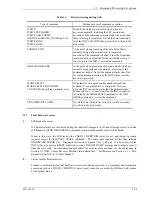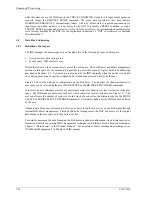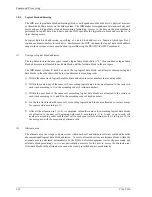
1.4 Command Queuing Function
C141-C010
1-17
When a command is in the queued state, if a RESET condition occurs, or if the IDD receives a TARGET
RESET message from any INIT, it clears all the commands in the queue. At this time, the IDD generates
on UNIT ATTENTION condition for all the INITs.
When an ABORT message is sent from an INIT that has issued a command which is in the queue, if the
correct LUN (0) is specified, only the command issued by that INIT is cleared and the other commands in
the queue are not effected. If the LUN is not identified, an ABORT message which specifies an illegal
LUN (1 to 7) does not effect the commands in the queue.
Untagged queuing exception processing (events and operations executed by the IDD) is shown below.
• If the TEST UNIT READY, REQUEST SENSE or INQUIRY command is received.
When one of these commands is received, if there is no link instruction in that command, the IDD
executes that command immediately without queuing the command or executing disconnect processing.
At this time, there is no effect on the commands from other INITs which are currently being executed, or
on the commands in the queue.
If these commands contain link instructions, they are queued.
• If disconnect processing is impossible.
If disconnect processing is impossible because the INIT which issued the command does not meet the
conditions for permitting a disconnect (see Section 1.3.3), or if the DISCONNECT message is rejected by
the INIT even though it meets the conditions for permitting a disconnect, the IDD responds with a BUSY
status without queuing the received command except the case described in item 1) in following Note
during executing or queuing command already. If this is not the case, the received command is executed
immediately.
• If the IDD is reserved
If the IDD has been reserved by an INIT using the RESERVE command and receives a TEST UNIT
READY command after that, when that command conflicts with the reserved state, it responds with a
RESERVATION CONFLICT status. Commands after that are queued, and the reserved state is checked
when a command is fetched from the queue. Conflicts with the reserved state are explained in the
description of the RESERVE command (Section 3.1.11).
Note:
Through the operation of the command queuing function, except for exceptions described on this
page, the IDD does not respond to commands issued by the INIT with a BUSY status. This function
is applied under the multi-initiator environment, and overhead for re-issuing commands caused by the
BUSY status is unnecessary. Normally, the INIT does not have to be aware of the existence of a
queuing function, but it is necessary to exercise caution in the following items when controlling
input/output processing.
1) When a command is queued, the time from the queuing of the command to its actual execution
will vary depending on the commands already in the queue, or on the content of the processing
currently being executed. Particularly in cases where the FORMAT UNIT command and
START/STOP UNIT command (Immed = 0), and data access commands which specify large
processing block counts, are already queued or being executed, the newly queued command will
be forced to wait a long time until it is executed.
2) In the following cases, a command may not be executed even after it has been queued.
Содержание 80
Страница 4: ...This page is intentionally left blank ...
Страница 10: ...This page is intentionally left blank ...
Страница 18: ...This page is intentionally left blank ...
Страница 62: ...This page is intentionally left blank ...
Страница 284: ...Sense Data Error Recovery Methods This page is intentionally left blank ...
Страница 296: ...This page is intentionally left blank ...
Страница 298: ...This page is intentionally left blank ...
Страница 308: ...This page is intentionally left blank ...
Страница 309: ......
Страница 310: ......
















































